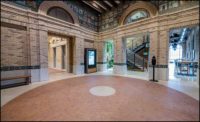A higher education campus presents an extensive amount of variables that can drastically impact the requirements of the indoor environment. These campuses are made up of various facilities and can include classrooms, housing, laboratories, food service, libraries, administration, recreation centers, and data centers, among others. Each one has unique conditions the designer needs to address when establishing project requirements.
Dehumidification will play a major role in the system’s ability to maintain the proper indoor environment. The capabilities and operation of each campus differs and the needs of all the stakeholders must be taken into account when determining the appropriate method to introduce and control dehumidification into the HVAC system. This article will present a case study for an archive room at a university’s library in southern California, offering an example of design and operation considerations for a critical indoor environment on a campus setting. The lessons learned for this type of space can easily be adapted to less critical spaces.
The university’s Special Collections & Archives department houses rare, unique, and valuable documents which require preservation and care in handling. As such, the requirements for tight temperature and humidity control are critical. At the onset of the design phase, in order to establish the loads for the respective space, the team must consider the ambient conditions, indoor conditions, envelope and space construction, indoor adjacencies, and internal loads. These assumptions should be discussed with the campus, especially the endsusers, to establish the basis of design.
The library building, which houses the archive room, is a three-story building originally constructed in the early 1970s. Two wings were added in the mid-1990s to bring the total space to 235,000 sq ft. The archive room, located on the second floor of the original building, is roughly 5,000 sq ft of critical environment storage. It includes exterior walls and shares interior adjacencies with non-critical environment library spaces (Figure 1). The exterior wall is constructed of 8-in LW concrete block and does not include any glazing elements.
Ambient And Indoor Design Conditions
The ASHRAE Fundamentals Handbook1 offers historical weather data with varying frequencies to establish the ambient conditions for over 6,000 locations globally. The summer design conditions are presented at intervals of 2%, 1%, 0.5%, and 0.1% frequency. These intervals represent the percentage of annual hours (8,760) where the actual temperature exceeds the listed design conditions. An archive room, and other critical environment spaces, should be selected at the 0.1% conditions. Although the focus of this article is on dehumidification, the design team also must address the low moisture conditions associated with the winter months and determine if humidification is necessary.
The selection of indoor conditions can play a major impact on the suitable HVAC solutions. There are numerous resources available for an archive room. Examples include ASHRAE Applications Handbook2, NISO TR01-1995 Environmental Guidelines for the Storage of Paper Products3, and the Collection Preservation in Library Building Design Guide4. The conditions in these resources differ enough to significantly influence the dehumidification requirements in the space, and in this example, the affected range of mechanical options available to handle this load. Coordination and approval from the enduser and campus on these conditions is critical. It is strongly recommended to document this information in meeting minutes as well as the Basis of Design. This project decided to use a temperature range of 67°F ±3°F and a rh range of 45% ±5%. The design rh range was the driving factor in the selection of the mechanical system.
Loads
Once the design conditions are agreed upon, the development of the load calculations can proceed. The design team needs to evaluate the other factors that will impact the load within the space, with special attention paid to moisture loads. These include envelope design, internal sensible and latent loads (i.e., lighting, equipment, people), and ventilation loads.
Most engineers take the envelope design for granted when sizing HVAC systems. In a critical environment application, the design team must not only address the sensible and solar loads of the envelope, but they should also pay special attention to infiltration and pressurization. Due to pressure differences between the building and the exterior, some air will leak into the building. The “tightness” of the construction will determine the amount of air and moisture that will leak into the building.
Newer codes and standards, such as ASHRAE Standard 90.1-2015, include specific language requiring a continuous air barrier. The design team must account for any operable windows and doors, as they are another source of infiltration and moisture. Operable windows would be most applicable to a dormitory building, but could also be used in other campus buildings. The project in this example was an existing 1970s building and was not provided with the air barrier seen in today’s codes, which directly affected the load.
Moisture loads from adjacent internal spaces must also be considered, especially for a critical application. Archive rooms are typically maintained at a tighter rh range and lower temperature than adjacent spaces (e.g., offices, library stacks, etc.). There are sensible losses associated with the temperature differential between internal spaces, but there are moisture loads from these spaces as well, including ceilings and plenums. In the archive room, the space was isolated from adjacent spaces with a full height wall, which drastically reduced the loads that the dehumidifier would need to handle. The introduction of moisture via infiltration of doors should be considered. The doors to the archive room were provided with seals to limit infiltration when the doors were closed. The design team should also consider the amount of time the doors will be open during normal operation to account for infiltration loads from adjacent spaces.
Occupant and ventilation loads play a part in the equation. Occupants give off not only sensible heat but latent heat as well. Latent heat is added to a space based on activity level of the occupant. Typical values can be found in the ASHRAE Fundamentals Handbook6. Ventilation load can affect the need for dehumidification capacity. As part of the mechanical and energy codes, ventilation is required based on a square-foot basis and occupant basis. The introduction of fresh air into a mechanical system will increase the requirements for dehumidification.
Lastly, equipment can be a source for moisture loads. Typical office equipment introduces sensible loads only; however, equipment from laboratories, kitchens, trade shops, etc., may introduce a moisture load to the space that will require dehumidification.
HVAC Options
Typical methods for providing dehumidification are dilution (mixing of return air and outside air), cooling coils, and desiccants. This article will focus on considerations for cooling coils and desiccant dehumidifiers since the introduction of outside air in an archive room can result in contamination. The selection of the appropriate system will be dependent upon available space, availability of chilled water, indoor design conditions, loads, etc.
Cooling coils involve an airstream flowing over a coil with a fluid circulating through the coil. Dehumidification occurs when the surface temperature of the heat exchange material is below the dew point of the air stream. The fluids are typically chilled water, low-temperature chilled water (glycol mixture), and refrigerants. The example archive room is located on a campus with a CHW plant with thermal energy storage and 24/7 operation. Under peak design conditions, the campus supplied chilled water at 40°F. However, the chilled water was reset during low campus load conditions to 48°F. This reset strategy made it impossible to achieve the dehumidification loads of the archive space using the central CHW plant. The team must understand the capacity and control strategy of the central plant in all modes of operations, not just peak conditions, if it is to be considered. The project team also considered local chilled water, low-temperature chilled water, and refrigerant-based systems. Since the archive room was located in the second story of an existing three-story building, the space constraints associated with these other options proved to be insurmountable.
The project team opted for a modular, ceiling hung AHU located above the space to handle the sensible loads (Figure 2). The unit included a 5,000 cfm AHU with a 6-row/8 FPI CHW coil designed for a peak entering water temperature (EWT) of 40°F and a 20°F delta T. The design team also had to ensure that the sensible load could be satisfied with a EWT of 48°F, per the campus reset schedule. The supply air is ducted to distributed diffusers in the archive space. The unit is 100% return air, which is accomplished via a return air plenum. As such, it is important to ensure that the space and plenum are isolated from adjacent spaces to minimize the moisture load within the system.
The archive room system incorporated a solid-type desiccant dehumidifier to handle the moisture loads within the space (Figure 3). For the solid desiccant system, moist air from the archive’s return plenum is drawn through the desiccant, which absorbs the moisture. This “dry” process air is then returned to the archive space. The moisture from the process air has been removed and stored in the desiccant. As the desiccant reaches its capacity, air from an adjacent space (reactivation air) is drawn into the dehumidifier and heated up. The moisture from the desiccant is released into the hot and dry reactivation air, which is then ducted to another adjacent space.
Conclusion
Dehumidification design in a campus setting is affected by a wide range of factors. The building stock includes existing and new facilities, with a wide array of space types. The campuses are typically served with centralized CHW utilities, which may or may not operate 24/7. In addition, the campus could be utilizing energy conservation measures (ECMs) that directly alter the ability of the system to provide dehumidification over the full range of operation. The design team must communicate with the campus and enduser to understand the requirements of the space(s) and evaluate the full spectrum of operation of the available systems. Proper selection of the dehumidification system will be dependent upon this understanding and agreement. ES
References
1. ASHRAE. 2013. Fundamentals Handbook, Chapter 14: Climate Design Information.
2. ASHRAE. 2015. Applications Handbook, Chapter 23: Museums, Galleries, Archives, and Libraries.
3. NISO TR01-1995. Environmental Guidelines for the Storage of Paper Products.
4. Ogden, B. Collection Preservation in Library Building Design Guide.
5. ASHRAE ANSI/ASHRAE/IES Standard 90.1-2013. Energy Standard for Buildings Except Low-Rise Residential Buildings.
6. ASHRAE. 2013. Fundamentals Handbook, Chapter 18: Nonresidential Cooling and Heating Load Calculations.







